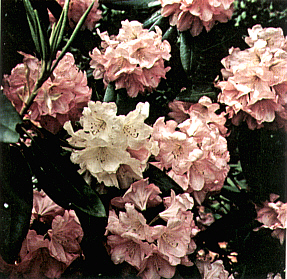QBARS - v27n2 Sporting Rhododendrons
Sporting Rhododendrons
George W. Ring, Fairfax, Va.

|
|
'Mary K' sport
Photo by George Ring |
Sporting rhododendrons not only like to live it up a little, they exhibit a changed habit, leaf, flower or other genetic characteristic. Sports are a form of mutation, that is, they have a rearrangement of, or different plant genes from the "normal" form. According to Webster, a sport can be either "a plant that assumes a character and appearance distinct from the normal type, or a bud or portion of a plant that assumes such a form." In botany, a sport is most generally intended to mean a part of a plant that is different from the remainder of the plant.
Mutations can be artificially induced through the use of non-radioactive chemicals such as mustard gas, nitrous acid, hydroxylamine and caffeine. Other chemicals such as colchicine and acenaphthene can produce changed plants through chromosome doubling. These are different from mutations in that their basic chromosome has not been altered. X-rays and gamma radiation have been used by agricultural scientists to bring about the development of new plants. Controlled levels of radiation induce physical changes in the plant cell through ionization. Many of the mutations thus caused are deleterious, having resulted in a loss of character rather than a gain. However, there have been a few notable exceptions, including the development of a rust resistant wheat.
In nature, changes in plant characteristics are thought to be mainly associated with either ionization caused by natural radiation, by ultra-violet light, or by plant viruses. Although plant viruses can result in a change of the plant's appearance, they are not necessarily a cause of mutations. Natural radiation and ultra-violet light are believed to create mutations principally through deletions, rearrangements and inversions of the basic gene. Occasionally the chromosome may be damaged, and in the process of repairing itself, result in a new kind of plant.
With all these possible causes of mutations, we should not wonder that sporting is fairly common in the plant world. Natural bud sports happen often on fruit trees, and branch sports are common in some evergreen azaleas. However, judging from the scarcity of published information, sporting in elepidote rhododendrons is rare. A few known or suspected sports are noted below:
| Plant | Comment | |
| Selected R. 'Caroline' rooted cutting |
| |
|
| (More compact - no bud browning) |
| |
|
| Branch on Dexter No. 9 | |Suspected by hybridizer in Massachusetts of | |
| (Different shaped leaf) | |being sports because of different plant habit. | |
| Selected R. 'Britannia'-rooted cutting |
| |
|
| (hardier-slower growing) |
| |
|
| R. 'Americana' | Grew out of a graft union of R. 'Britannia' | |
| and R. discolor , grown by Ben Lancaster. | ||
| R. maximum rubra | Changes from white to pink or red and | |
| back again in subsequent years. Reported both | ||
| by a grower of five forms in Cumberland, | ||
| Maryland and at Joseph Gables | ||
| R. 'Fastuosum Flore Pleno' | There is speculation in the literature that | |
| this might be a sport of R. catawbiense , although | ||
| it is listed most places as a hybrid of R. catawbiense | ||
| x R. arboreum . | ||
| R. 'Mother of Pearl' | Supposedly a sport of R. 'Pink Pearl.' | |
| R. 'Mary K' | White truss of flowers on an otherwise | |
| mauve-pink plant. At Joseph Gables - 1972 | ||
| - hybrid of R. catawbiense x R. fortunei . | ||
| R. 'Elizabeth Lockhart' | A sport of R. 'Hummingbird' (R haematodes | |
|
x R. williamsianum ), raised by Prof. R. D. |
||
| Lockhart, England. | ||
Of the sports listed above, three are apparent changes in plant habit, one is a graft-union sport, one is a species having an unstable flower color gene, another is speculation and the last three are spontaneous branch sports of true hybrids having different colored flowers.
'Mary K' and Sport
'Mary K' is a selected light pink (with lavender-mauve tint) form of R. 'Catalagla' x R. fortunei grown by Joseph Gable in Stewartstown, Pa. Mr Gable made this cross around 1960. In 1972, 'Mary K' sported one truss of white flowers for the first time. The white sport truss may be seen in the illustration.
'Mary K' has been in its present location for about eight years and has always been a prolific bloomer and perfectly hardy. Its leaves measure up to 9-1/2 inches long and the truss is large and formal, as opposed to a loose, informal R. fortunei truss. Each truss carries about 14 flowers. The plant is now about 6 feet tall and 7 feet across.
The white sport of 'Mary K,' if the sporting continues, should be a fine plant in its own right. Cuttings have been taken from the sporting branch and the truss has been selfed to determine whether the white form can be propagated.
Reference:
"Create New Flowers and Plants - Indoors and Out" John James, Doubleday and Company, Inc. 1964.
